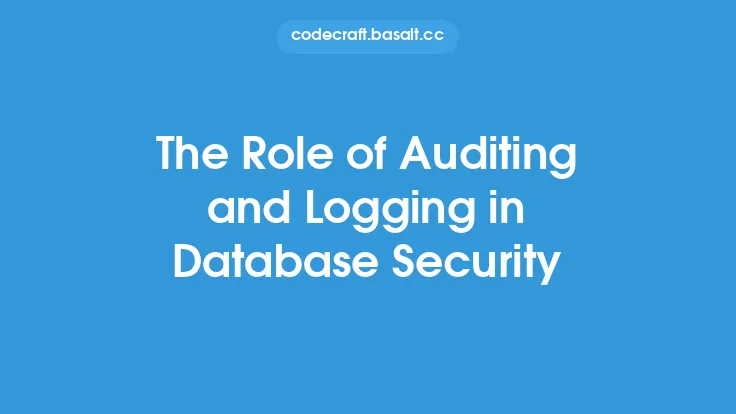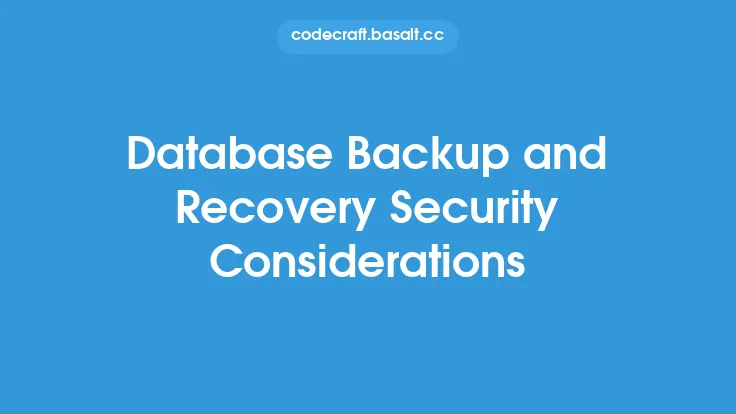Database security is a critical aspect of protecting sensitive data from unauthorized access, use, disclosure, disruption, modification, or destruction. As databases continue to play a vital role in storing and managing vast amounts of data, the risk of security threats and breaches has increased significantly. In this article, we will delve into the common database security threats and discuss ways to mitigate them, ensuring the confidentiality, integrity, and availability of data.
Introduction to Database Security Threats
Database security threats can be categorized into several types, including internal and external threats. Internal threats originate from within the organization, such as unauthorized access by employees or contractors, while external threats come from outside the organization, such as hackers, malware, and denial-of-service (DoS) attacks. Some common database security threats include unauthorized access, data breaches, SQL injection attacks, cross-site scripting (XSS) attacks, and malware infections. These threats can compromise the security and integrity of the database, leading to financial losses, reputational damage, and legal liabilities.
Types of Database Security Threats
There are several types of database security threats that organizations need to be aware of. These include:
- Unauthorized access: This occurs when an individual or group gains access to the database without proper authorization, potentially leading to data breaches or modifications.
- Data breaches: This involves the unauthorized disclosure of sensitive data, which can be caused by internal or external threats, such as hacking, phishing, or physical theft of devices.
- SQL injection attacks: This type of attack involves injecting malicious SQL code into a database to extract or modify sensitive data.
- Cross-site scripting (XSS) attacks: This occurs when an attacker injects malicious code into a website, which is then executed by the user's browser, potentially leading to unauthorized access or data breaches.
- Malware infections: This involves the introduction of malicious software into the database or related systems, which can compromise the security and integrity of the data.
- Denial-of-service (DoS) attacks: This type of attack involves overwhelming the database or related systems with traffic, rendering them unavailable to legitimate users.
- Insider threats: This occurs when authorized personnel intentionally or unintentionally compromise the security of the database, potentially leading to data breaches or modifications.
Mitigating Database Security Threats
To mitigate database security threats, organizations can implement several measures, including:
- Implementing access controls: This involves restricting access to the database to authorized personnel only, using techniques such as authentication, authorization, and accounting (AAA).
- Encrypting sensitive data: This involves converting sensitive data into an unreadable format, using encryption algorithms such as AES or RSA, to protect it from unauthorized access.
- Regularly updating and patching software: This involves keeping the database management system (DBMS) and related software up-to-date with the latest security patches and updates.
- Monitoring database activity: This involves tracking and analyzing database activity to detect and respond to potential security threats in real-time.
- Implementing intrusion detection and prevention systems: This involves using specialized software and hardware to detect and prevent intrusion attempts, such as SQL injection attacks or malware infections.
- Conducting regular security audits and risk assessments: This involves regularly assessing the database security posture to identify vulnerabilities and implement corrective measures.
- Providing security awareness training: This involves educating authorized personnel on database security best practices and the importance of protecting sensitive data.
Best Practices for Database Security
In addition to implementing measures to mitigate database security threats, organizations can follow best practices to ensure the security and integrity of their databases. These include:
- Using secure protocols for data transmission: This involves using secure communication protocols, such as SSL/TLS, to protect data in transit.
- Implementing data backup and recovery procedures: This involves regularly backing up sensitive data and having procedures in place to recover data in the event of a security breach or system failure.
- Using secure database configuration and hardening techniques: This involves configuring the DBMS and related systems to minimize vulnerabilities and prevent unauthorized access.
- Implementing auditing and logging mechanisms: This involves tracking and analyzing database activity to detect and respond to potential security threats in real-time.
- Using secure authentication and authorization mechanisms: This involves using secure authentication and authorization mechanisms, such as multi-factor authentication, to restrict access to the database.
Conclusion
Database security is a critical aspect of protecting sensitive data from unauthorized access, use, disclosure, disruption, modification, or destruction. By understanding the common database security threats and implementing measures to mitigate them, organizations can ensure the confidentiality, integrity, and availability of their data. Additionally, following best practices for database security can help prevent security breaches and ensure the long-term security and integrity of the database. As the threat landscape continues to evolve, it is essential for organizations to stay vigilant and adapt their database security strategies to address emerging threats and vulnerabilities.





